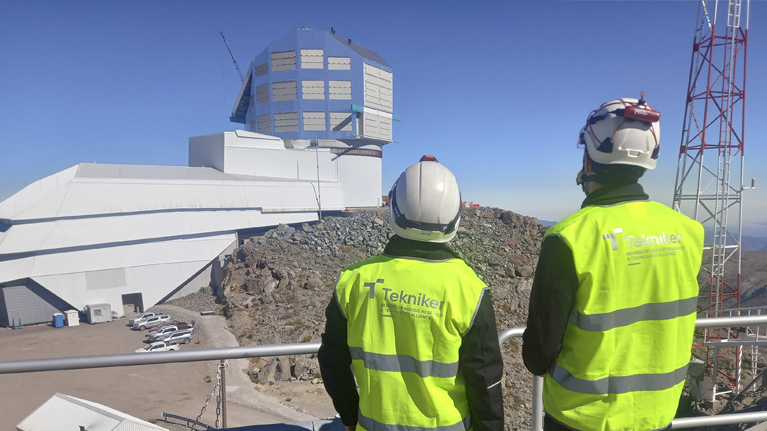Tekniker collaborates in the construction of a major telescope in Chile
Researchers from the technology centre have travelled to the Atacama Desert to provide their know-how and expertise to build one of the world’s most ambitious astronomy projects.

The Rubin Observatory telescope is one of the world’s most ambitious astronomy projects. Erection work is currently underway in the Atacama Desert in Chile, and it has been estimated that once work finishes in 2024, the telescope will offer the scientific community a new vision of what the universe looks like thanks to the high-accuracy images it will provide of all the sky that is visible from the Earth.
In order to do so, this very large piece of equipment will be fitted with a mirror that is as wide as a tennis court and will feature the biggest digital camera ever to be used in an astronomy project, namely, a 3,200 megapixel device that weights more than 3 tons and whose level of resolution compared, for instance, with a top-of-the-range cell phone, is 200 hundred times greater.
The turnkey contract covering the design, manufacture, assemblage, testing and commissioning of the telescope mount at the Rubin Observatory has been executed by the GHESA-Asturfeito consortium. Tekniker, a member of the BRTA alliance, has been able to participate in a project that poses a significant technological challenge thanks to its state-of-the-art facilities and expertise. Ghesa/Empresarios Agrupados asked the technology centre to design and develop the telescope’s control system, a key element that will allow the mirror to position itself very quickly, completely vibration-free, to scan the visible sky.
Fine-tuning in Chile
In 2022, several Tekniker researchers and staff from Ghesa/Empresarios Agrupados travelled to the site where the equipment was being assembled, namely, the Vera C. Rubin observatory, situated in Cerro Pachón (Chile) at an altitude of 2,600 metres to ascertain that all the technological solutions supplied had been properly installed and adjusted.
More specifically, experts from the technology centre performed all the fine-tuning work and adjustments required to check that all the software and control algorithms designed and developed at Tekniker were running correctly. Their purpose is to improve the accuracy of the equipment when moving, totally vibration-free and meeting all dynamic requirements. All of this work has been done on-site and under real operating conditions at the telescope’s definitive location.
Thanks to this technology, it is possible to either fully rotate the telescope in only 36 seconds or move it very slowly when more than 114 years would be required to complete a full rotation.
The Tekniker team is also helping to improve the accuracy and operation of the system that provides rotation for the telescope’s digital camera. In order to do so, the researchers replaced the trajectory generator with in-house designed ad-hoc generators and modified the motion monitoring device.
The technology centre also provided know-how on how to develop the camera’s cable rotator, a somewhat less critical mechatronic device that is used to prevent operational interferences. Tekniker’s solution can smoothly wind or unwind the cables and pipes that run all the way to the camera when rotating, i.e., when it takes photographs of the visible sky.
Validation process
Prior to performing installation work in Chile, all of Tekniker’s developments underwent an extensive validation and testing process in Asturias at the facilities of a company called Asturfeito before the pandemic broke out that was eventually followed by assembly work for the telescope’s 460-ton main structure measuring 10 m in diameter.
Researchers ran on-site control software tests to guarantee precision of the main mount shafts and checked maximum system speed and acceleration settings and also how long it took to stabilise the unit after it moved.
Simulations of how the software had to be installed at the telescope’s final location were carried out at Tekniker’s laboratory after the trials run in Asturias. In Chile, the researchers were assisted by Empresarios Agrupados, the company in charge of designing, assembling and testing the equipment on-site at Cerro Pachón.
The work done by Tekniker on this telescope proves that the organisation is fully able to make capabilities and technologies converge to specifically focus on designing advanced solutions aimed at some to the world’s most outstanding projects thanks to collaborative actions with customers such as the European Spallation Source or Sener related to building space satellites. The technology centre has also made other contributions based on providing technologies for projects such as, among others, the Gran Telescopio Canarias (GTC), the accelerator of subatomic particles (ISIS – United Kingdom) and the International Thermonuclear Experimental Reactor (ITER).
More about the telescope
A budget of more than 700 million dollars was earmarked to build the telescope with the help of a team comprising more than 100 professionals made up of astronomers, physicists, engineers and experts working for leading telescope manufacturers such as the Spanish firm GHESA, the Italian company Phase, the Swedish organisation SKF and Heidenhain from Germany.
Once commissioned, the telescope will deliver top-quality images of the visible sky to the scientific community to further research actions. It will be possible to scan the sky every 3 or 4 nights to pinpoint and analyse significant variations seen in the universe in the form of exploding stars or asteroids that could potentially crash into the Earth. As large-size pictures will be produced, 1,500 high-definition TV screens will be required to visualise each one of them.
More pictures of the project on Flickr.
